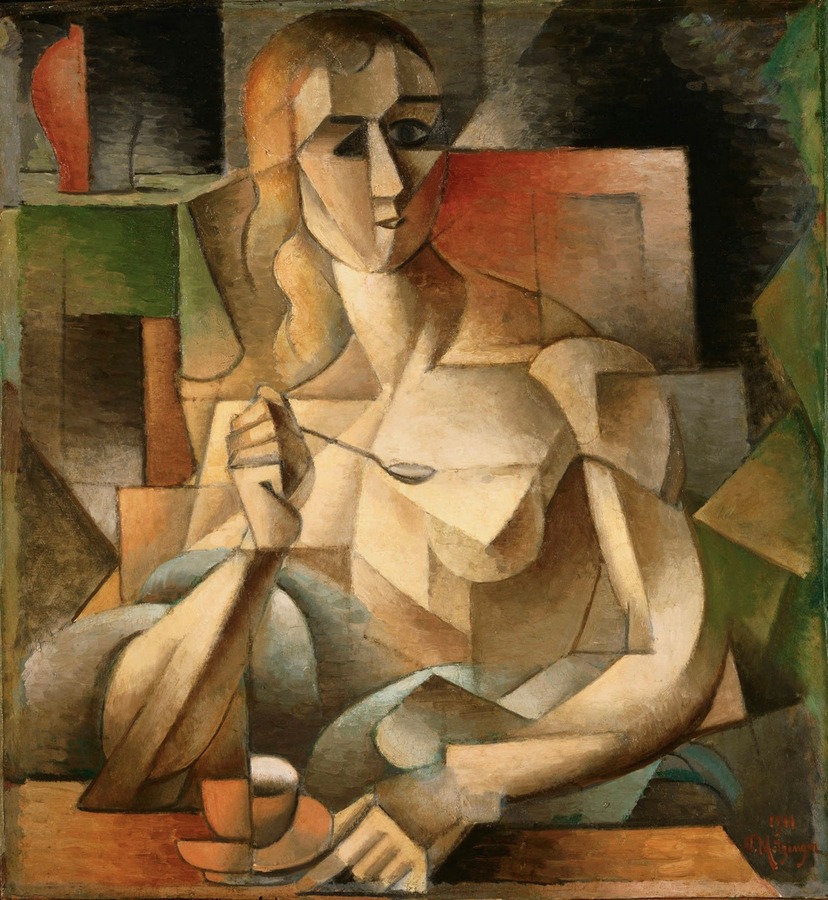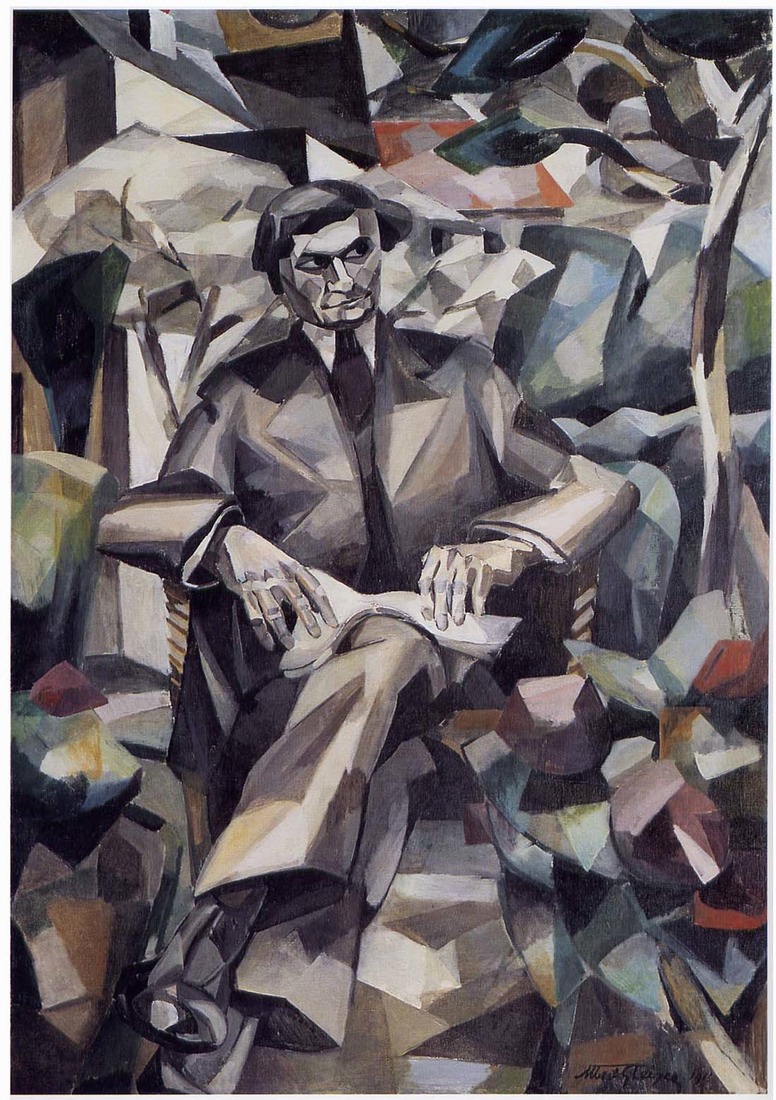Back to Du "Cubisme" index
Back to Souvenirs index
Previous
AFTER THE INDÉPENDANTS
Each year the Belgian Independent painters would invite some foreign painters to join them. After the Indépendants we were called on to participate in their next exhibition. We were grouped together in a room of our own and Guillaume Apollinaire was asked if he would come to Brussels to give a talk on us. This was the occasion on which Guillaume evoked the name of 'Cubists' which had been bestowed on us without our having asked for it; he accepted once and for all that the word 'Cubism' corresponded to the novel appearance of the painting which had just appeared.
[.....]
There was now not very much time before contributions had to be sent to the Salon d'Automne. Léger had gone to spend the holiday with his family in Argentan. Le Fauconnier, after going to Italy, had stopped in Savoy where he painted landscapes he intended to show in the Automne. Metzinger and I had stayed near Paris - he was at Meudon and I was at Courbevoie. We saw a lot of each other and naturally tried out plenty of ideas starting of course with our ways of understanding painting. The result was a sort of grinding together [rodage] of differences that continued to exist despite the general principles on which we were all agreed and which had enabled the realisation of a momentary homogeneity and the presentation of the overall movement in Room 41. But each of us knew very well that we were only at the beginning of an adventure whose eventual resolution we could not possibly foresee. We knew that what we were doing at the present time was only a preparation for what we would be doing later - which would be far removed from it both in spirit and in technique.
So our differences in 1911 were not categorical oppositions. They were, rather, propositions which were worthy of reflection. Each of us owed it to the other to test them. The future development of our premisses would be the better for it. The grinding together which I want to speak about of Jean Metzinger's ideas with my own, at least with regard at that time to painting, resulted from the confrontation of our positions. This was the time when Metzinger was painting Le Goûter and some large, animated landscapes. I had painted La Chasse, La Femme à la cuisine. From my walks around Meudon I had brought back a large landscape, Paysage à Meudon. I was about to undertake an ambitious portrait, of Jacques Nayral. When we confront the works of these two painters, both known by the same label, we can easily understand the meaning that should be given to the word 'divergence'.
Metzinger, as can clearly be seen in Le Goûter, proceeds through the interpenetration [emboîtement] of cubes. The construction of his painting turns on the orchestration of these geometrical volumes, which shift their position, develop, interweave following the movements in space of the painter himself. Already we can see, as a consequence of this movement introduced into an art which, we were told, had no relation to movement, a plurality of perspective points. These architectural combinations of cubes supported the image as it appears to the senses, that of a woman whose torso is naked, holding in her left hand a cup while with the other hand she lifts a spoon to her lips. It can be easily understood that Metzinger is trying to master chance, he insists that each of the parts of his work must enter into a logical relationship with all the others; each should, precisely, justify the other, the composition should be an organism as rigorous as possible and anything that looks accidental should be eliminated, or at least kept under control. None of that prevented either the expression of his temperament or the exercise of his imagination.

Jean Metzinger: Le Goûter, 1911
Oil on cardboard, 75.9 cm × 70.2 cm
Philadelphia Museum of Art, The Louise and Walter Arensberg Collection
I admit frankly that this austere, scientific [savant] discipline did not appeal to my own state of mind. Although I had made some progress towards the predominance of the laws of construction over the accidental characteristics [épisode] of the subject, I still could not separate these two aspects of the painted work, and I remained firmly attached to the subject. This was my starting point in trying to arrive at the more purified plasticity that was the object of my aspirations. So I defended my position and tried to find persuasive arguments to oppose to those of Metzinger. But I was far from denying that his position was valid and I was quite willing to accept those shifts in perspective which seemed to me to be the whole point of, and to cast a remarkable light upon, the orchestration of the cubes, which was perfectly logical but obviously rather limited. This was how, between the two of us, what I have called a 'rubbing together' took place through which, some months later, we were able to engage in a collaboration that resulted in the first book to be written on Cubism.
I was on the verge of painting the Portrait of Jacques Nayral. He was to become my brother-in-law, and was one of the most sympathetic men I have ever met. A strange lad, a little surprising on first encounter - both disturbing because of his sharp use of irony and also attractive because of a generosity that left him as vulnerable as a child. The first time I met him was at President Bonjean's house at Villepreux-les-Clayes, near Versailles, during a dinner which brought together the committee of that 'Free Villa Medici' (10) which, as I said before, had been founded by Alexandre Mercereau. From that time onwards, we saw each other often and became friends.
(10) Georges Bonjean (1848-1918), magistrate who was an advocate for radical penal reform especially with regard to minors, aiming at reform rather than punishment. He also opposed the Republican laws against the religious orders. The intention of the short lived Villa Medicis Libre was to provide living accommodation for married artists. André Lhote and Raoul Dufy were both based there in 1909 (André Lhote, catalogue of a retrospective exhibition in the Musée de Valence, 2003, p.246).
[.....]
One day he asked me to do his portrait. I agreed with joy, all the more so because his head and his whole personality [personne] seemed to me to be perfect models for emphasising the plastic elements I was trying to develop. His face with clearly demarcated surfaces that made up a passionate interplay of facets, his hair in dark masses projecting lightly in waves over his temples, his solidly constructed body - straightaway suggested to me equivalences, echoes [rappels], interpenetrations, rhythmic correspondences with the surrounding elements, fields, trees, houses. So I suggested painting him in my garden, where I found easily to hand an environment that was highly suitable for my model.

Albert Gleizes: Portrait de Jacques Nayral, 1911
Oil on canvas, 180x130 cm
Tate Gallery, London
I made a whole series of studies to prepare this portrait. Drawings and washes in china ink. I analysed the architecture of the head in monumentally sized enlargements, two or three times the natural size, I made a certain number of drawings of the hands, I studied the organisation and the overall effect, volumes and the relations of the formal elements between themselves. Finally, I reduced the colour to a harmony of blacks and greys supported by some flashes of light red which set up a contrast, at once breaking with and supporting the interplay of harmonious colour relations. Nayral came regularly to the studio, I worked directly on him, naturally, but more often than not the work consisted in friendly conversation, in walks in the garden, during which I studied him, watching what was his natural way of walking and what were his usual gestures, above all arming my memory with essential characteristics, trying to isolate his true likeness from the accumulation of details and picturesque superfluities which always interfere with the permanent reality of a being. The portrait was executed without turning to the model, it was finished some weeks before the Automne and I decided to show it ... if the jury would be willing to accept it, as I was not yet a member.